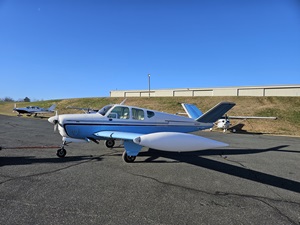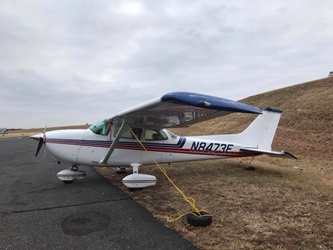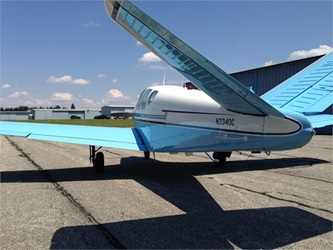The Aircraft Spotlight typically looks at an airplane type and evaluates it across six areas of particular interest to flying clubs and their members: Operating Cost, Maintenance, Insurability, Training, Cross-Country, and Fun Factor. This month we’ll do a cost comparison between the Cessna 172 and the early V-tail Bonanzas.
One of the most important decisions a club will make is choosing an aircraft. The 3 Amigos Flight Club has a fleet that consists of a Cessna 150 and three Cessna 172s. For a short time, the club had a 1955 V-tail Bonanza as well, but soon realized it wasn’t a good fit in a club environment [See this month’s Club Spotlight].
Everyone knows the Cessna 172. It was introduced in 1956 and is still in production. More than 44,000 have rolled off the assembly line, making it the most produced aircraft in the world. Over the years there have been some design changes and upgrades to avionics, but the basic airplane remains the same.
“As far as taking a look at the viability of what aircraft to use in a club environment, you really can't beat a 172,” 3 Amigos Flight Club President Roger Beck said. “The parts are out there, and they are fairly easy to work on. They are the generic airplane.”
The V-tail Bonanza is one of the most recognizable general aviation aircraft ever built. It was introduced in 1947 and produced until 1982. The combined rudder and elevator, called a “ruddervator” gives the plane a sleek look and a 175-knot cruising speed. “It’s a nice airplane to go zipping here and there,” Roger said.
He has a 1947 Bonanza, which is his aircraft, and a 1955 F model that was in the club in 2017. “Look at the engineering that went into [those planes]. One of the reasons why I'm sold on the V-tail Bonanza is that they're great flying airplanes, but I'm not a doctor,” Roger said, referring to the plane’s nickname—“forked-tail doctor killer.” The plane developed a reputation because of a number of crashes typically by wealthy pilots who were a little too confident in their flying abilities.
Operating Cost
Cessna 172
The value of early 172s (models A-H, which were produced between 1956 and 1967) range from about $55,000 to $75,000, according the Vref, the aircraft valuation service. The I-M models (late 1960s through mid-1970s) are valued in the $90,000 to $125,00 range, while the N-P models (made in the late ‘70s through 1986) range from $140,00 to $160,000. Models produced from the mid-90s start around $200,000 with newer 172s closer to $500,000. Costs will vary depending on the engine, avionics and total time.
The 3 Amigos has a 1967 172H with a 150-hp Continental O-300, and two 172N models made in 1977 and 1979 with the 160-hp Continental O-320 engines. In cruise they burn about 8 gph, Roger said. The club charges an hourly maintenance contribution of $75, Tach time dry for all of its 172s.
In terms of fuel capacity, the 1967 and 1977 models hold 40 gallons each. The 1979 model has the long-range tanks that hold 50 gallons, which extends the flight time by another hour. The one drawback is at full fuel, and with some of the other equipment in the plane, the useful load is only about 400 pounds compared with an almost 800 pounds useful load in the other 172s.
V-tail Bonanza
The purchase price on a V-tail Bonanza ranges from about $50,000 to $70,000 for early models (1947 through 1960). Later models (mid-60s through 1982) range from $100,000 to $200,000 for a 1982 V35B, according the Vref. Cost will vary depending on the engine, avionics and total time, but V-tail Bonanzas are less expensive than the larger A36, making it a reasonable option with similar performance.
The 1947 Bonanza has the 205-hp Continental E-185 and the 1955 F model has the 225-hp Continental E-225. Roger pointed out the Bonanza is quicker to altitude than the 172 because it has a larger engine.
The 1947 holds 40 gallons of fuel with about 37 gallons usable. The F model holds 94 gallons, which includes tip tanks that hold 40 gallons. With that kind of range and speed, the Bonanza is well-suited for cross-county flying.
“What I'm experiencing in cruise with the Bonanzas is about 10 gallons an hour, and the Bonanza is a full 40 knots faster than 172,” Roger said. “Your operating cost per mile is probably a little less on the Bonanza than it is on the 172.”
The newer Bonanzas and 172s have bigger engines, so it’s important to remember this discussion is comparing the vintage models rather than the newer versions of these aircraft.
In 2017, when the Bonanza was in the club, the maintenance contribution was $85 an hour, Tach time, dry.
Maintenance
Cessna 172
A base annual for a 172 is about $1,200, Roger said. Once you add in routine wear and tear items like oil and brakes, it usually comes out to about $1,500. That is assuming no additional work is found. The maintenance shop is billing at $107 an hour, so costs will vary based on local rates. With so many 172s built over the years, parts are readily available, and mechanics are familiar with them. Roger also said they are fairly easy to work on.
V-tail Bonanza
An annual for a V-tail Bonanza is going to be a bit more than a 172, because of the retractable gear. The initial annual cost is about $1,500, and is about $1,800 to $2,000 once the wear and tire items are added in.
“The Bonanza is such a well-built airplane and it's such a simple airplane that the annuals on those usually are not very expensive,” Roger said. “If I run into an issue with one, it’s usually a pretty simple fix.”
However, there have been some maintenance issues and some airworthiness directives and speed restrictions put on some early variants. Models with the larger engine starting around 1955 also had larger ruddervators and were prone to structural failure, so there is AD that strengthened the tail spars.
In addition, the Bonanza was originally made with an electric prop and parts are scarce, so finding good usable parts can be a challenge. Most Bonanzas have been retrofitted with a hydraulic prop so it’s not an issue.
One other thing Roger looks for on a Bonanza pre-buy is when the wing bolts were last changed. This is periodic maintenance that has to be done every 13 years.
Insurability
Insurance runs a little more on the V-tail Bonanza than on the 172, but that’s expected with a complex, high-performance aircraft. The 3 Amigos keeps costs down by requiring members to have their private pilot’s license before joining, so the club doesn’t do primary training.
When the Bonanza was in the club, the insurance company required club members to have 10 hours in make and model, as well as a specified amount of complex, high-performance time. Although the plane is no longer in the club fleet, Roger has a policy that allows a pilot with an IFR rating, a minimum of 700 hours, and 10 hours make and model to fly the plane. Anything less than that, Roger can call and find out what the insurance premium would be, and the other pilot would pay the additional Insurance. He’s only offered that opportunity to one or two members that he knows well, but right now no one else flies the Bonanzas besides him.
It's important to remember “the Bonanza is a very fast airplane, and you need to think ahead of it by a couple of minutes or else it will turn around and bite you simply because it is that fast,” Roger said. “It's slippery.”
Overall
A club can’t go wrong with a Cessna 172. It’s economical to operate, it’s easy to maintain, and parts are plentiful. It may not be fancy, but it is reliable and familiar to most pilots.
The V-tail Bonanza is a little more expensive to operate but will provide more performance and comfort. Depending on the club’s mission and the type of flying the members do, it offers a distinctive aircraft at an affordable price. It’s a good cross-county aircraft that will get you where you want to go quickly, with a reasonable fuel burn. But keep in mind, with the older models, parts maybe harder to come by and pilots need to stay proficient in the aircraft because it is more complex. “For somebody who knows how to fly these planes, they're wonderful,” Roger said. “They are absolutely wonderful airplanes.”